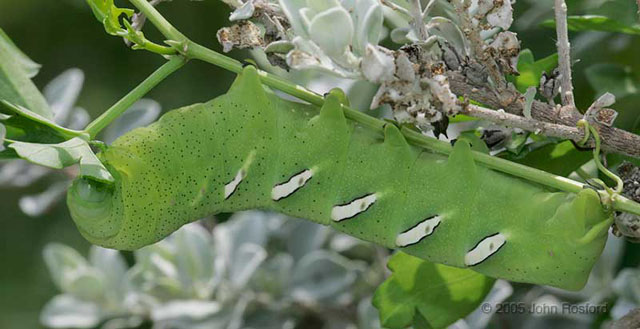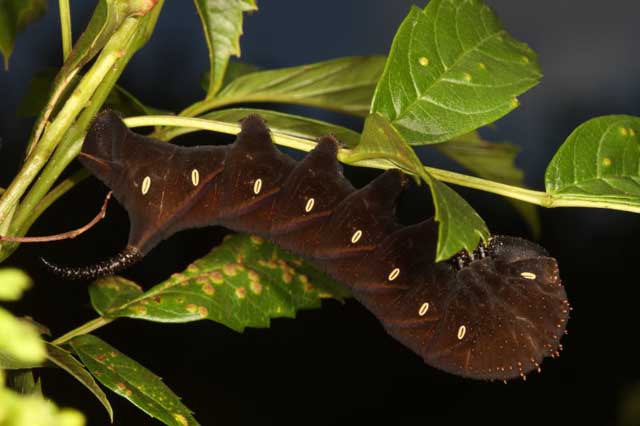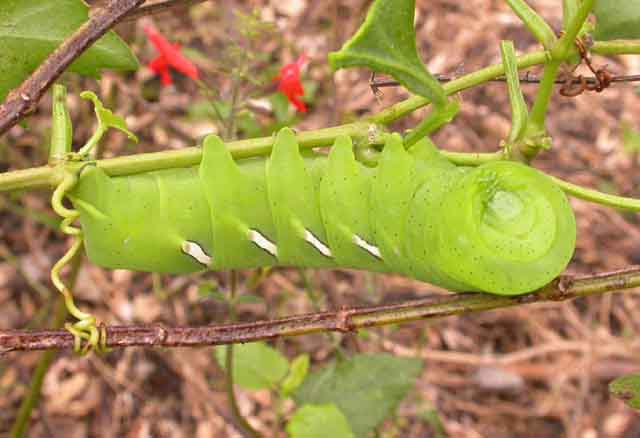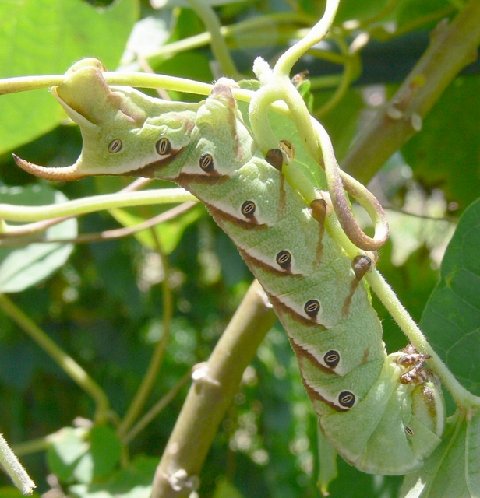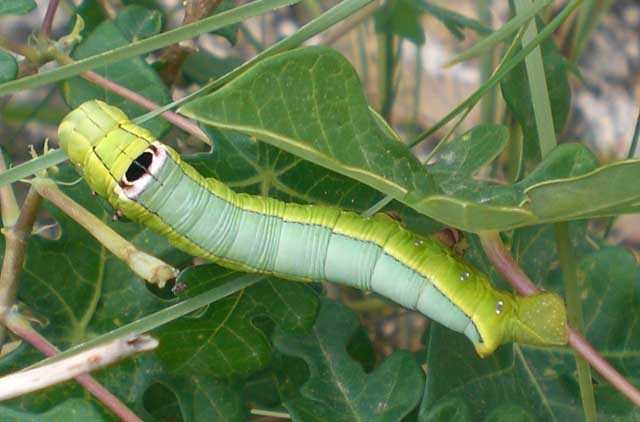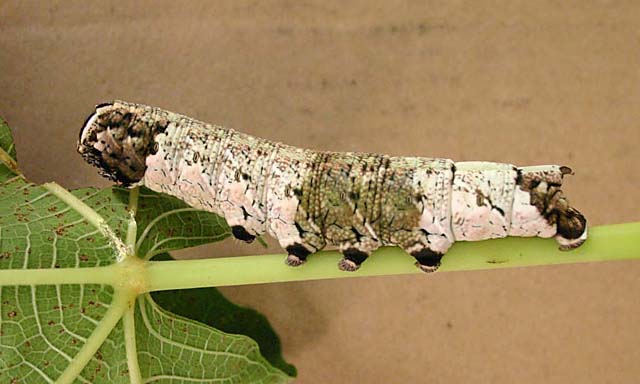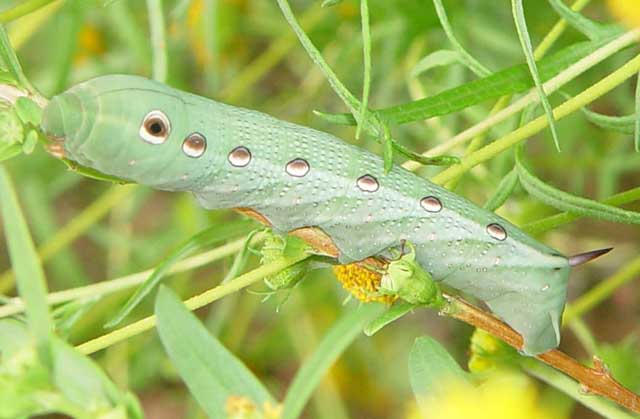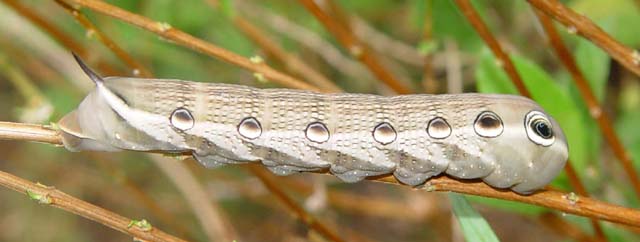Sphinginae subfamily
Sphingini tribe:
 |
Agrius cingulata,
USGS Pink-spotted hawkmoth,
Hosts: Convolvulaceae family, especially Ipomoea batatas (sweet potato) and Solanaceae family,
especially (Datura) (jimsonweed) and related plants in the
Americas. Aalso a brown form. Look for very large, dark
spiracular circles.
|
Cat Traylor larval image at bottom of page.
 |
Ceratomia catalpae
USGS,
Catalpa Sphinx
Feed gregariously on Catalpa species
(Catalpa bignoniodes and C. speciosa) in
Bignoniaceae family, skeletonizing the foliage.
Larvae are mostly white in early instars.
generally more eastern species |
 |
Fraxinus, Ligustrum, Quercus, Crataegus and
Chionanthus virginicus are listed as hosts.
In the fifth instar, the spiracular ovals are decidedly red and the
anal horn is off-white to pinkish laterally.
|
 |
Dolba hyloeus
USGS, the Pawpaw Sphinx
Larvae feed on pawpaw (Asimina triloba), littleleaf sweetfern
(Myrica aspleniifolia), possum haw (Ilex decidua), and
inkberry (Ilex glabra) as well as Tall Gallberry Holly
(Ilex coriacea).
generally more northern and eastern species
|
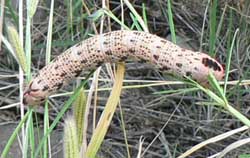 | Istar Sphinx larvae feed primarily on mints (Salvia).
|
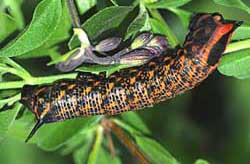 |
Lintneria separatus
USGS,
Separated Sphinx.
Salvia greggii has been confirmed as a larval host by Robert A. Behrstock.
Jim Tuttle, tentative id, writes, "All of the
penultimate instars of both Lintneria (Sphinx) istar and
Lintneria (Sphinx) separatus that I have reared have been mundane green."
|
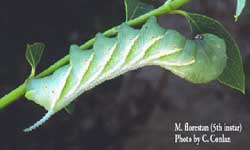 |
Manduca florestan
USGS Prominent, extended side slashes determine this species.
Yellow side slashes often occur on larvae feeding on foliage with yellowish
underside veins. In penultimate instar, anterior three
slashes are accentuated. (stray)
|
 |
The caterpillars are called Tomato Hornworms and each has a black horn at the end of the abdomen.
Larvae feed on potato, tobacco, tomato, and other plants in the
nightshade family (Solanaceae).
|
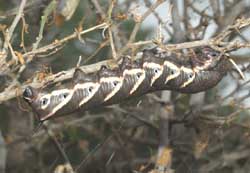
|
The caterpillars are called Tomato Hornworms and each has a black horn at the end of the abdomen.
Larvae feed on potato, tobacco, tomato, and other plants in the
nightshade family (Solanaceae). There is also a very beautiful brown
form to the left.
|
 |
Manduca rustica
USGS, Rustic Sphinx.
Numerous white nodules on top of thorax;
seven pairs of oblique, blue-gray stripes along body side.
Horn white at base and blue-gray at tip. Many hosts are utilized.
Also a dark brown-black form with black horn.
|
Dark form image near top of page, courtesy of Bo Zaremba.
 |
Tobacco Hornworms, equipped with a red-tipped horn at the end of the
abdomen, are true gluttons and feed on tobacco and tomato, and
occasionally potato and pepper crops and other plants in the
nightshade family (Solanaceae).
|
 | Preferred hosts are common trumpetcreeper (Campsis radicans),
Florida yellow-trumpet (Tecoma stans), lilac
(Syringa species), and
passionflower (Passiflora species).
The anal horn is blue, preceded by a yellow dash.
|
|
Sorry, no larval image is available at this time.
|
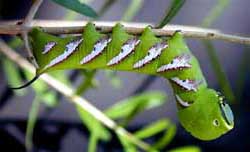 | Larvae feed on New Mexican forestiera
(Forestiera neomexicana), on Forestiera angustifolia
and on little leaf ash (Fraxinus gooddingii) in the Oleaceae
family. There are green and dark forms and all larvae tend to darken
just before pupation.
|
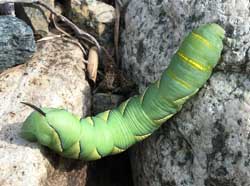 |
Mature larvae are
green with seven pairs of lateral, white, oblique bands which
are bordered anteriorly with black. The anal horn is smooth and black.
Note the bands of gold dots on the thorax. (stray) |
Smerinthini Tribe:
None reported
Macroglossinae subfamily
Dilophonotini tribe:
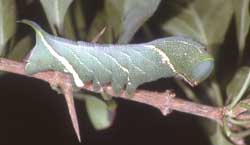 |
Larvae feed on various species of the Rubiaceae (madder) family.
Randia rhagocarpa, Randia monantha, Randia aculeata, Guettarda
macrosperma and Genipa americana are listed as hosts. Probably only further south.
|
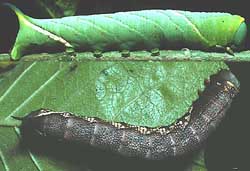 |
Larvae feed on seven year apple, Casasia clusiifolia, common
buttonbush, Cephalanthus occidentalis, and white indigoberry,
Randia mitis. Randia monantha, Randia aculeata,
Albizzia adinocephala and Randia grandifolia, all in the
madder family (Rubiaceae), also serve as hosts. rare |
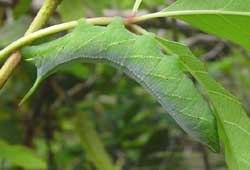 |
Larvae probably feed on
Vitus tiliifolia and other members of the Vitaceae family:
Vitis, Cissus, Ampelopsis. In Florida larvae have been
reported on larvae on Possum Vine
(Cissus sicyoides) and Pepper Vine (Ampelopsis arborea).
|
 |
Larvae feed on papaya (Carica papaya), nettlespurge
(Jatropha), and allamanda (Allamanda).
|
|
Sorry, no larval image is available at this time.
|
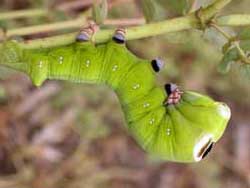 |
Larvae feed on papaya (Carica papaya), Cnidoscolus
angustidens, poinsettia (Euphorbia pulcherrima),
guava (Psidium species) and
saffron plum (Bumelia angustifolia/Bumelia celastrina).
Manilkara bahamensis,
Willow Bustic (Bumelia salicifolia)
and Painted Leaf (Poinsettia heterophylla) are also hosts.
Nice socks! Larvae show considerable variation.
|
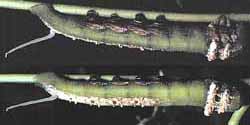 |
Larvae feed on papaya (Carica papaya), Manihot esculenta
and various plants (Macroscepis obovata) in the milkweed
family.
|
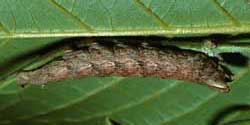 |
Erinnyis obscura, the Obscure Sphinx,
USGS
Larvae feed on Rauvolfia ligustrina, Rauvolfia tetraphylla,
Stemmadenia obovata, Philibertia, Cynanchum, papaya
(Carica papaya), Asclepiadaceae, Blepharodon mucronatum,
White vine (Sarcostemma clausum) and Morrenia odorata.
|
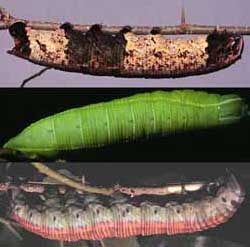 |
Females feed and lay eggs on fig leaves, especially Strangler Fig
(Ficus aurea). Ficus carica, Ficus microcarpa, Ficus
religiosa, Ficus pumila, Ficus gamelleira, Ficus prinoides, Ficus
pumila and Artocarpus integrifolia are also listed as
hosts.
The extreme variability of larvae is shown to the left.
The few images that have been sent to me for identification help
are usually as per the upper image.
|
Visit Pachylia ficus
courtesy of Beatrice Cruz and students, Harlingen, Texas.
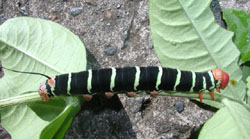 |
Pseudosphinx tetrio, Tetrio Sphinx,
MQ.
Larvae defoliate Frangipani tree (Plumeria spp.)
They generally start at tip of leaf and work back.
Caterpillar: velvety black with yellow rings and orange head;
growt up to six inches long; also feed on
Allamanda cathartica; probably other members of
Dogbane family: Apocynaceae.
|
Philampelini tribe:
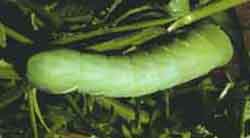 |
Eumorpha megaeacus larvae feed at night upon
Jussiaea species and upon members of the primrose family
(Onagraceae). stray
|
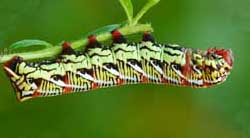 |
Eumorpha fasciatus
USGS, Banded Sphinx.
Hiosts: primrose-willow, Ludwigia (water primrose),
other plants in evening primrose family. Hornless, highly variable larva . Look for large, dark spiracular circles and a dark
line in the center of the back. See image at bottom of this page.
|
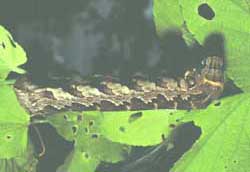 |
Eumorpha labruscae
MQ, the Gaudy Sphinx
In Florida larvae have been found on Possum Vine
(Cissus sicyoides).
Cissus incisa, Cissus verticillata, Eupatorium odoratum, Ludwigia,
Magnolia, Parthenocissus and Vitis vinifera are all
reported hosts.Larval patterning strongly suggests a small snake.
|
 |
If you have Grape or Virginia Creeper nearby, then you might encounter
this species. Note the five large white ovals. There are orangey-brown and green
forms also.
generally more eastern species |
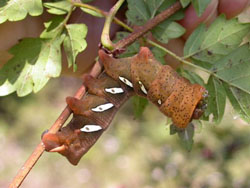 |
In Eumorpha satellitia the white panels are completely
enclosed in black whereas in E. vitis the ends of the black
panels remain open. Also, satellitia has a faint subdorsal
longitudinal stripe that touches the top of the white panels that is
lacking in vitis. I suspect there is also a green form.
|
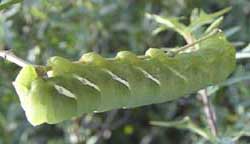 |
Eumorpha vitis
USGS/John Rosford,
the Vine Sphinx
Eumorpha vitis vitis larvae feed upon grape foliage (Vitis) and
other vines (Cissus): Cissus pseudosicyoides
and Cissus rhombifolia and Cissus sicycoides.
I suspect there would be a brown form.
Note five, smooth, narrow, oblique white lines.
|
Eumorpha vitis larva, Hidalgo
County, John Rosford, October 27, 2005
Macroglossini tribe:
 |
In additon to Virginia creeper larvae accept Grape (Vitis),
ampelopsis (Ampelopsis), and cayenne pepper (Capsicum).
Larvae are green until the final instar.
|
 |
Cautethia spuria
USGS,
the Spurious Sphinx
Larvae feed on
Coutarea hexandra, Chiococca alba and
Chiococca pachyphylla and probably other species of the Rubiaceae family.
rare stray; varied larval forms
|
 |
Hyles lineata
USGS, the White-lined Sphinx
Larvae are highly varied and feed on a great diversity of plants
including willow weed (Epilobium), four o'clock (Mirabilis),
apple (Malus), evening primrose (Oenothera), elm
(Ulmus), grape (Vitis), tomato (Lycopersicon),
purslane (Portulaca), and Fuschia.
All larvae seem, however, to have the red/black swellings split by
dorso-lateral lines. |
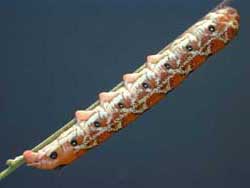 |
Proserpinus juanita BAMONA, Juanita Sphinx:
Newly-hatched caterpillars eat eggshells. (Onagraceae) including evening primrose (Oenothera), gaura (Gaura),
and willow weed (Epilobium). Michael Van Buskirk has found them on Guara biennis in Missouri. rare
|
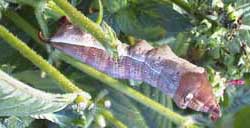 |
Xylophanes pluto
USGS,
the Pluto Sphinx
Larvae feed on Milkberry (Chiococca species), Firebush
(Hamelia patens), Indian Mulberry (Morinda royoc) and
Erythroxylon species.
There are three known colour morphs: green, brown, and purple/brown.
The false eyes are rather striking.
|
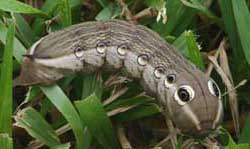 |
Xylophanes tersa
USGS,
the Tersa Sphinx.
Larvae also feed on Borreria, Catalpa and Manettia spp. and
Smooth buttonplant (Spermacoce glabra) and starclusters
(Pentas species). They are also recorded on joe-pie weed and
Hamelia patens and on Hedoydis nigricans. The green form may be more common.
|
|
|
